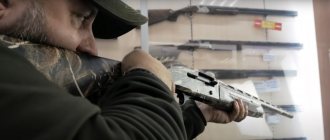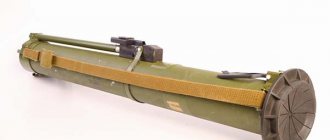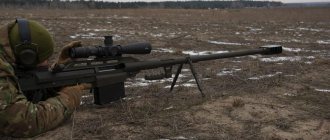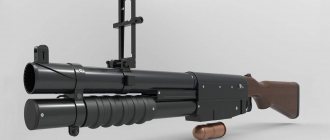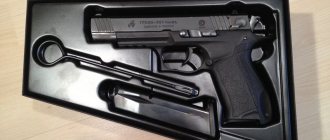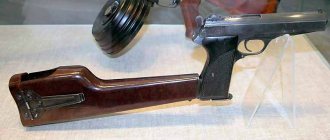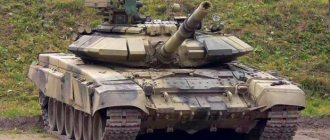A ballistic knife is a knife with a projectile blade that can be removed from the handle using a spring mechanism. Originally designed for use by special forces and operatives, this knife is spring-powered and virtually silent. The dagger-like blade is great for stabbing. It can be used as a regular slashing weapon, or a piercing weapon that can be launched using an internal spring.
Historical reference
The ballistic knife owes its appearance to the American military department, which in the early eighties of the 20th century learned to design silent weapons that could throw steel blades over a short distance. The mechanism is quite simple: a spring is built into the handle of the knife, which is pre-compressed before firing. The blade is installed on top and secured with a special bolt.
According to the developers, such a simple system allows you to throw a blade at a distance of up to 10 meters with an initial speed of about 16 m/s (this is approximately 60 km/h). This is several times faster than a regular knife strike. This is where questions begin, for example, what kind of spring is installed, how to compress it to obtain such a powerful force. After all, this is not an air rifle with a one-gram bullet; the blade will be heavier. We must also not forget about the problems of all air rifles, in which the spring, which is cocked for a long time, loses its elasticity and becomes ineffective.
The birth of weapons and their scope
Today you can hear different opinions about where and by whom the ballistic knife was first invented. Some attribute the idea of creating a shooting knife to Arthur Conan Doyle, the creator of the immortal image of the English detective Sherlock Holmes. Others are betting on the authors of the film about James Bond, a British superspy who had a wide variety of weapons in his arsenal. The idea that the flying knife is the weapon of spies and detectives is undeniable. Another thing is that the ballistic knife really owes its appearance to the American intelligence services and the military department.
For reference: The prototype of the flying knife was an ancient Chinese invention. Back in the Middle Ages, weapons of this type were common in China. The bamboo tube was equipped with a powerful spring. The projectile was a shortened arrow with a long tip.
At the height of the Cold War, American engineers learned to create models of silent weapons that were equipped with intelligence agencies and special forces. Initially, it was planned that silent flying knives would become a convenient means for quietly eliminating the enemy, so the main focus was on developing a design suitable for sabotage units. Weapons are only effective when used correctly. The flying blade can only cause damage if it hits unprotected areas of the body. When attacked by an enemy equipped with basic body protection, the effectiveness of such weapons is reduced to zero.
One silent shot can hit an enemy at a distance of 10-15 m. The maximum effectiveness of combat use is achieved at a shorter distance. American samples showed good results during testing. From a distance of 5-7 m, a flying blade is capable of inflicting a wound 10 cm deep. The blow must be as accurate and true as possible. There is no time to reload a ballistic knife.
The emerging weapon models differ not only in their mechanism and operating principle, but also in appearance. Some knives are blade-shaped, while others have a short blade that more closely resembles an arrowhead. The only thing that all models have in common is the ballistic properties of the flying blade. The blade must fly along a smooth path and its cutting edge must be well sharpened.
As it turns out, it is quite difficult to realize the destructive capabilities of ballistic knives in practice. Anyone who plans to use such weapons for combat purposes must have the appropriate skills and dexterity. You shouldn't count on flying knives as your main and serious weapon. However, with enough training and experience, a fired blade can become the only “magic wand” that can solve the problem. In this case, we can talk about the tactical advantage that this type of weapon has. No enemy can be prepared for the fact that he can be covertly hit with cold steel from a distance. Ballistic knives can be used from any position, standing, sitting or lying down. In order to strike, there is no need to swing and apply some physical effort.
This weapon did not receive widespread use. This was facilitated by the limited scope of application of ballistic knives. In addition, special forces in any army today do not practice the use of flying knives in their work. An ordinary combat knife, finka or dagger is much more effective and useful in combat and in extreme conditions.
Combat use
Melee weapons of this type, according to the Americans, should be used to silently eliminate enemy personnel. After all, the goal of any special forces is to solve the assigned task without noise and fuss, going back unnoticed by others. To do this, the ballistic knife must stop or paralyze the enemy for a few seconds so that he does not have time to signal an attack.
The American spring mechanism is capable of hitting an enemy only in the neck area, which, as a rule, is not protected by body armor. After all, all other parts of the body are hidden under a large amount of clothing - any army knife will be ineffective here.
At the end of the 20th century, a group of American university students conducted independent research to determine the effectiveness of a throwing blade from a cold weapon. Naturally, the driving force was the American spring. The experiments were carried out on killed animal carcasses, access to which was provided by one of the country's meat processing plants. Both the knife strike and the shooting of the blade were recorded. The characteristics of the knife declared by the government were refuted, and political charges were brought against the researchers.
American propaganda
Even after decades, there are many fictitious stories floating around about Russia in the world community, which are instantly destroyed when turning to historical information. Gun myths are no exception. If it’s stupid, it means it was created in the USSR. There are exceptions, but they are related to the defense industry of the state, so it is not customary to talk about them with a stranger.
Myths about the miracle knife were generated by American propagandists, who announced that the ballistic knife was the fruit of the work of Soviet gunsmiths. The appearance of a knife that shoots using a spring dates back to the end of the Great Patriotic War. However, in fact, there is not a single document that would confirm the statement made by the Americans. And if you look at history, you can find only two knives that were adopted into service - the legendary AK bayonet and the Soviet reconnaissance weapon NR-43 "Cherry".
Many legends can be found in the media about the Russian representative of shooting knives under the brand name “N-148 Scout”. Anonymous users tell wonderful stories that this knife is able to pierce concrete and crumble brickwork. However, there is not a single historical document confirming the production of these weapons.
But the idea is interesting
A knife with a detachable blade was developed by Tula gunsmiths in the mid-80s of the last century. However, instead of a spring, the blade was ejected by powder gases. The handle of the knife had a built-in barrel consisting of six grooves, and at the bottom there was a live SP-4 cartridge of 7.62 mm caliber.
The weapon received the marking NRS-2 (scout knife, shooting). Weapons were developed for special army units, but mass production was never established. It's all about a very large number of requirements and narrow scope of application. But judging by the specifications of the Tula Arms Plant, the production of knives with a detachable blade has not stopped; they are still produced in limited quantities under government orders.
If you look at the information provided by foreign media, you will find that the NRS-2 knife with a detachable blade was adopted by the USSR Ministry of Defense along with the PSS Vul silent pistol.
Shoot a knife
Various combined shooting devices have been known for hundreds of years. At the dawn of the development of firearms, both pistols with a blade and bladed weapons with the ability to fire a bullet were very popular. As for shooting knives, they remain the standard weapon of many scouts to this day.
Special scout knife
The KGB was the first in the USSR to think about developing a shooting knife for sabotage purposes. In the 50s, on instructions from the KGB, work began on the first version of such a combined design at the Tula Arms Plant (TOZ). The ammunition chosen was the SP-2 cartridge with a cutoff of powder gases in the cartridge case, developed at the Tula TsKB-14 by Igor Yakovlevich Stechkin. Thus, edged weapons became not only shooting, but also silent.
In 1956, such a cartridge and weapons for it were adopted by the KGB. There is no exact information about whether it was a shooting knife or a shooting TKB-506 cigarette case. A little later, the development of a double-barreled pistol began at the TOZ design bureau using a silent cartridge. Work on the design of weapons (both a knife and a pistol) was led by engineer Rafail Khlynin.
The Main Rocket and Artillery Directorate (GRAU) of the USSR Ministry of Defense soon became interested in unique developments for the KGB. The weapon was modified for the new, more advanced SP-3 cartridge. As a result, in the 70s, the special reconnaissance knife (SRS) entered service with army special units under the symbol 6P25.
LDC kit russianarms.ru
The knife itself is a familiar but greatly improved 6x4 bayonet design. The tip of the blade can pierce a sheet of steel 1 mm thick, and with the help of a saw on the butt of the blade you can saw through even a 10 mm steel rod. The NRS sheath serves not only to protect the knife blade, but also as scissors, capable of cutting wires with a diameter of up to 5 mm, including those energized up to 400 V. The knife with the sheath, using a special fastening, can be placed both on the shin and on the arm . A pendant is used to carry the knife on the waist belt, and a bandoleer is used to carry an ammunition load of four cartridges.
A single-shot firing device is built into the handle of the knife; the barrel and chamber are easily accessible for loading or unloading the weapon. The barrel has two holes for water to escape when using the LDC underwater, but firing is only allowed on land. To protect the barrel bore from the muzzle there is a rubber curtain with ready-made cuts for the unhindered passage of the bullet. Sometimes it is mistakenly called a seal due to its visual similarity to PBS rubber plugs. However, for SP-3 cartridges with cut-off of powder gases in the cartridge case, they are not required. The knife comes with five spare curtains, black for summer and white for winter.
To fire a shot from the LDC, you need to turn the blade towards you with the blade up and aim using the sight slot on the limiter (guard) and the front sight on the back of the handle. On the side of the handle there is also a cocking mechanism in the form of a lever made of a metal plate. On the same side are the trigger lever and safety lever.
Shooting from a special scout knife M. Mikhin
Reviews about the use of LDCs in the military are extremely contradictory. Some believe that the additional ability to fire a silent shot perfectly complements the main functions of the knife, others are of the opinion that at short distances it is easier and more effective to throw a knife than to shoot it. However, such a unique weapon as the LDC became the standard weapon of the Soviet intelligence officer.
Second generation LDC
Confirmation that the LDC has taken root in the troops, contrary to the prevailing contrary opinion, was the modernization of the knife and the appearance of its second generation. The blade of the new knife was unified with a 6x5 bayonet, which took a similar shape. The blade took on a straight dagger shape and became double-sided by reducing the length of the saw.
NRS-2 voentv.by
The main improvement of the system was the new silent cartridge SP4. It is much more powerful than its predecessor and has high penetration ability. If the SP-3 at a distance of 25 m is capable of piercing only two pine boards, then the SP4 at the same distance hits manpower in a 6B1 body armor or pierces a 2-mm steel sheet. However, in this case, the already low accuracy of fire was sacrificed. In 1986, the special reconnaissance knife NRS-2 under the symbol 6P31 was adopted by the USSR Ministry of Defense.
If there is no need to fire a knife, a weight and size insert is inserted into it instead of a firing device. There are factory versions of HP and HP-2 knives, which initially do not have the ability to fire a cartridge. They differ mainly in the design of the handle.
Knives NRS-2 (above) and NR-2 (below) V. Kuzmin
Until recently, NRS-2 pistols were produced at TOZ. According to official data, more than 60 knives were produced in 2013 and 2014. There is no information about the further release of NRS-2 in open sources. Perhaps with the advent of a new generation of silent SP16 cartridges, an even more deadly version of the shooting knife will appear.
Tula "Set"
At the Tula Central Design Research Bureau for Sporting and Hunting Weapons (TsKIB SOO), designer V. Rebrikov in 1978, on his own initiative, designed a whole survival kit. The “Set” product included a knife, an ax and a saw. The knife of this set had a firing mechanism similar to the NRS. In this case, the muzzle of the barrel is directed from the handle to the side of the blade that is more familiar to the shooter. The center line of the bore is located above the blade, which does not exclude its influence on the flight of the bullet.
Two pistol calibers were used as ammunition for the weapon - 5.45 and 7.62 mm. The knife was fired with MPTs cartridges for the PSM pistol and silent SP-3 cartridges for NRS and SMEs. Despite the versatility and wide functionality of the “Kit,” at the end of the 70s, the special NRS knife was already in service with special units and was being deployed into mass production.
Two variants of OTs-54 chambered for SP-4 and 9×18 mm KBP cartridges
In the 90s, the Tula TsKIB SOO again remembered shooting knives designed by Rebrikov. The survival kit had to be abandoned, and the shooting knife was supposed to come in four calibers. To the silent SP4 (instead of SP-3) and small-caliber MPC, cartridges for 7.62 mm TT and 9 mm PM were added. The knife received the index OTs-54 and was unsuccessfully offered by the Tula people for arming various law enforcement agencies. The latest version of the special combat knife OTs-54-2 used 9x18 mm PM and 7.62 mm SP4 cartridges, which were current in the 2000s.
Based on the OTs-54, a shooting knife for combat swimmers was developed. Such weapons could be fired with 4.5 mm SPS and PU cartridges. To be able to use a cartridge with a length of 145 mm, the barrel was located in the blade of the blade.
Underwater shooting knife KBP
At the Tula Military Artillery Engineering School, a team led by Yu. Danilov developed a four-barreled Chameleon knife. The 5.45 mm caliber barrels located in the handle were intended for firing MPTs pistol cartridges. The barrels were located two on both sides of the blade with the direction of fire along it, like the OTs-54. Moreover, to reduce the influence of the blade itself on the ballistics of the bullet, there were longitudinal recesses on its side surfaces along the line of the barrels.
To load, the buttplate of the handle was folded down, and all cartridges were simultaneously inserted into the chamber, fastened with a clip. The Chameleon allowed self-cocking firing, which increased the combat rate of fire to 15 rounds per minute. There was even a seat for a laser designator on the handle. The product was offered for traffic police and traffic police officers, complete with a sheath in the form of a traffic controller's baton. Thanks to the long handle, an option for combat swimmers was also considered.
Four-barreled "Chameleon" Magazine "Weapons"
Knives by Igor Skrylev
In the 90s and 2000s, the famous Russian bladed weapon designer Igor Skrylev developed a whole family of different shooting knives. In his developments, he used both principles of firing - both along the blade (like the OTs-54), and in the direction from the blade from the back of the handle (like the NRS).
The Skat survival kit includes a shooting device with a smooth stiletto-shaped barrel. The Skat uses .410 caliber or 15-mm signal cartridges as ammunition. For the usual 9x18 mm cartridge, Skrylev’s collection includes a four-barreled “Scorpion” with a dagger-shaped blade.
Stiletto "Scat" and knife "Scorpio" Magazine "Soldier of Fortune"
The most universal development of Skrylev is the Leshy-2 knife, which is an analogue of the army LDC. To securely hold the knife when firing a powerful SP4 cartridge, a lanyard is used that covers the shooter’s hand. A folding barrel is attached to the lanyard, which prevents its loss in the field. The possible arsenal of the Leshi is quite impressive - in addition to the silent SP4, as well as the usual 5.45x18 mm and 9x18, there are also smooth-bore calibers 12.5x35 of the Dog revolver and .410. A special version of the 12.5 mm cartridge in a 32-caliber cartridge case was developed especially for the knife.
Knife “Leshy-2” and variants of ammunition used Magazine “Soldier of Fortune”
There is another version of such a knife, “Pilot-2,” intended for the Air Force, which is fired from a barrel that is additionally screwed onto the back of the handle. It is designed for shooting 15 mm signal cartridges or 5.6 mm small-caliber rimfire cartridges.
With all the variety of shooting devices created by various design bureaus and talented engineers, only the Tula shooting special reconnaissance knives NRS and NRS-2 received a start in life.
Characteristics of special knives
| Name | LDC | NRS-2 | OTs-54-2 |
| Index | 6P25 | 6P31 | – |
| Caliber, mm | 7,62 | 7,62 | 7,62 / 9 |
| Cartridge | SP-3 | SP4 | SP4 / 9×18 |
| Weight, g | 330 / 600* | 350 / 620* | 750 |
| Length, mm | 280 / 323* | 283 / 332* | 307 |
| Width, mm | 32 | 34 | 41 |
| Height, mm | 54 / 65* | 54 / 65* | 70 |
| Blade length, mm | 160 | 160 | 160 |
* —
sheathed
Sources and literature:
- Technical description and operating instructions for the special scout knife (SRS). M.: Voenizdat, 1979
- I.A. Skrylev. Russian knives: combat, hunting, tourist. M.: Astrel, 2009
Advantages and disadvantages of such weapons
If we compare a regular army knife with a throwing weapon, the latter has a slightly greater advantage in defeating the enemy. After all, it can be used in battle and as a regular knife. And in case of danger, just one silent shot can hit a target at a distance of up to 25 meters. But judging by numerous reviews of experts in the media, the distance is greatly exaggerated. In fact, targeted shooting is possible from a distance of no more than five meters. The penetration of the blade is impressive - when fired into a board, the blade can go deeper by 100 mm. This is quite enough to cause damage to the enemy.
The shooting knife is a single-shot weapon, and this is its huge drawback. A fighter may not have enough time to reload in battle, so you should definitely have a second knife available.
Shot
To take aim, you need to take the shooting knife with the blade towards you so that the index finger of your right hand is on the trigger lever. The blade is clamped between two palms, and the crosshair (guard) rests on the thumbs. In this case, the palm of the left hand is placed on top of the palm of the right hand. Under no circumstances should you place your fingers on the muzzle, for obvious reasons. Aiming occurs using a slot on the guard and a front sight at the end of the handle. Now you can fire a shot with a smooth release of the hook.
The shot has recoil, but its force is no greater than that of a PSS pistol. At the same time, the shooting scout knife fires a quieter shot, since it has no moving parts, and the spent cartridge case does not fly out.
About shape and proper sharpening
If you review ballistic and throwing knives, you will notice that they have almost the same shape. To some, it resembles an even fang. Some compare the blade to a bullet, while others tell a story about its resemblance to the body of a shark. If you listen to everyone and look closely, there will be no reason for argument. After all, the name “ballistics” implies the ideal flight of the blade to the target, and what it looks like is no longer so important.
But special attention is paid to sharpening weapons. After all, the sharper the cutting edge, the more effective the blade will be in passing the obstacle. Naturally, the knife blade is sharpened on both sides. Regardless of what size knives are used, the technique is the same for everyone.
- The passage along the sharpener starts from the back of the blade at an angle of 40 degrees.
- When you reach the point where the blade begins to bend, you need to raise the handle to maintain a constant sharpening angle.
- At the end point of the passage, the tip remains on the block.
- Each subsequent edge is sharpened using the same technique as the first.
Handle
The barrel is located at the back of the handle. The muzzle is located at the end of the handle and is covered with a split rubber curtain. On the crosshair-limiter (guard) there is a slot that serves as a rear sight. Accordingly, there is also a front sight, which is located at the end of the handle. It can be adjusted in height. On the other side, on the crosshair, there is a petal with a hole, which is needed to remove the used cartridge case from the chamber. The handle is made of green or brown (less common) color and has large mesh corrugation.
Where does the wind blow from
It is interesting that there is so little information in the media about the use of throwing bladed weapons in the Middle Ages. After all, firearms have not yet celebrated their millennium, and humanity learned about edged weapons only when they learned to process metal.
There is information, quite a lot of it in history textbooks. For example, during the Inquisition, trained witch hunters used the prototype of a shooting knife. A wooden or ceramic tube contained a compressed spring, on the edge of which a silver blade was placed. The gun was worn in a sleeve, the shot was fired by straightening the arm in the direction of the enemy. The knife handle could be used many times. Perhaps this device was the world's first ballistic weapon.
Preparing to shoot
To load the NRS (scout shooting knife), you need to move the locking device and, turning the barrel, remove it from the handle. A cartridge is then inserted into the chamber. After this, holding the barrel with the chamber up, you need to insert it back into the handle so that the protrusions on the barrel fit into the grooves carved into the firing device box. Then you need to turn the barrel and return the locking device to its place. All that remains is to cock the trigger. To do this, turn the cocking lever all the way up and release it. The fuse box must be set to the “fire” position.
Rare weapons
Unique weapons are sometimes found in museums and private collections. Multi-blade knives are no exception. The blades of weapons have different designs. This is caused by the need to hide the spare blade in the handle. When one of the blades fires, the second one extends and locks in the firing position.
Why design bureaus did not adopt such a wonderful and promising technology remains a mystery. After all, in essence, the problem with carrying a second knife is solved. And if you develop the idea further in this direction, you can come to the idea of creating a whole cassette of small blades that can be shot one by one. You can forget about the spring mechanism, but the use of powder gases is quite possible, as is the use of compressed air or inert gas.
Knife equipment
The shooting knife comes with a number of accessories. The kit includes:
- Accessory case.
- Insert for handle. Replaces the firing device in the handle. Allows you to practice techniques without worrying about the risk of deformation of the mechanisms.
- 2 pendants for wearing. One is waist, and the second is hip.
- Obturator. Serves to prevent the breakthrough of powder gases through the gap between the barrel bore and the projectile belt at the beginning of the shot.
- Ammo bag.
- Spring.
- Sheath.
Pneumatic knife
In 1993, the Barracuda ballistic knife appeared on the arms market. The blade in it was ejected not by a spring, but by compressed air. True, its design is very primitive - the bulky body of the compressed air cylinder compared to the size of the knife clearly spoils the first impression. Not to mention the bypass valve, which is indispensable during repeated shooting.
This development turned out to be more successful when compared with a firearm and a spring mechanism. The device is quickly and easily serviced and charged. Good tactical and technical characteristics make the pneumatic knife very attractive on the weapons market - from a distance of five meters, a steel blade pierces through a 50 mm pine board.
Knife design
Why does this knife have this name? The fact is that the flight of the blade is carried out along a ballistic trajectory. Modern types of design of this product were equipped with springs. In later versions, they were already equipped with special devices that launched the blade with pressure obtained from compressed gas. The weapon functioned thanks to the following principles:
- the blade is fixed in a hollow handle;
- the fighting mechanism is a powerful spring or piston;
- in gas-powered models, the gas cylinder is placed in the handle;
- the trigger mechanism has a lever that locks the blade in a hidden position;
- it is necessary to check or pin the fuses that will keep the blade from accidentally starting;
- pressing the lever releases the latches, after which the mechanism is activated.
Classified as "Secret"
It is interesting that automatic knives with a flying blade, using the energy of compressed gases, are mentioned in many documentaries dedicated to the USSR State Security Committee and GRU units. For example, the program “Military Secret” talks about a unique case when Soviet intelligence officers pursued an experienced saboteur near the coast of the Baltic countries who was trying to break through underwater to a submarine located nearby. They managed to stop the criminal with the help of a ballistic knife, firing a shot in the buttock.
There are many options and everyone can decide for themselves what to believe. In a beautiful fairy tale presented to the viewer in the form of a documentary film, or in the fact that there is still a military secret that it is better not to talk about, much less look for answers to questions of interest.
What prevents an alternative solution?
Ballistic automatic knives, according to their purpose, have an excellent alternative in the form of a combat pistol with a silencer, which is several times superior to the tactical and technical characteristics of a throwing blade. The same noiselessness and ease of wearing, together with a high rate of fire and multiple charges, simply leave no chance for melee weapons.
As many experts in the arms business assure, it’s all about the legality of carrying, acquiring and storing firearms and bladed weapons. And if there are no problems with the law of the Russian Federation “On Weapons” if you find a seemingly ordinary knife whose blade length does not exceed 90 mm, then any pistol will always attract attention. This development of events is clearly not suitable for a real spy or intelligence officer. And if you remember the story about the use of throwing weapons under water, then a firearm simply has no chance of surpassing a knife.
SP-4 cartridge
The cartridge was created specifically for silent fire from PSS pistols and other types of special weapons, including knives. It is considered a closed-type ammunition, since the powder gas after the shot is locked in the cartridge case thanks to a special piston that pushes the bullet. Complete gas cut-off and subsonic initial cut-off ensure noiselessness. The cartridge is equipped with a cylindrical bullet, which weighs exactly 10 grams and has a brass leading belt. Its hardness ranges from 53 to 58 on the Rockwell scale, which provides high penetration ability. The cartridge itself has a length of 42 millimeters, of which 41 mm is occupied by the extractable cartridge case.
Interest of criminal structures
The review of switchblade knives also partially affects criminal structures, where it is customary to use homemade weapons with a switchblade. Their main difference from military models is the extension of the knife blade with fixation in the combat position. That is, the blade is not fired, but cocked from a hidden position.
There are two types of knives used in criminal circles: with end ejection and side ejection of the blade. Both mechanisms are almost the same, because the main purpose of the weapon is to quickly cock the blade into a firing position. Cocking is carried out using a spring mechanism and is not particularly difficult. An important component in such knives is the end position lock and the blade reverse lock. In the countries of the former USSR, including Russia, the presence of a lock on a switchblade, regardless of the material from which the knife handle is made, is prohibited for blades whose length is more than 9 centimeters and width more than 2 cm. Therefore, manufacturers freely avoid punishment by reducing the length and the width of the cutting edge.
Blade shooting knife
In addition to firearms, there is also a knife that shoots blades. This type is easier to manufacture and operate, but less suitable in combat conditions. He shoots with his own blade, after which only the handle remains in the fighter’s hands. How to make a shooting knife of this type? Very simple. A spring is installed in the hollow handle, on which the blade is placed. Then the blade is fixed with a part resembling a grenade pin, and the knife is ready. If necessary, the pin is pulled out and the blade flies out.
Guarantees are always needed
And since we are talking about throwing a blade over a distance to defeat an enemy, we remember a very popular edged weapon that is in service in all countries of the world - a throwing knife. There is one similarity between these two types of weapons, which directly depends only on the technique of using the weapon - the one-time use. When shooting a blade (or when throwing), an unsuccessful hit leads to the loss of the combat weapon. But special forces soldiers carry up to a dozen combat blades, which can be thrown one at a time and quickly delivered to the target. But with concealed carrying there may be problems.
Both for a shooting knife and for a throwing weapon, there are a number of manufacturing requirements: simplicity, lightness, aerodynamics, the ability to camouflage and similar characteristics. We're not even talking about the complex blade sharpening system, on which the effectiveness of the weapon depends.
Western analogues
Western special forces also widely use this kind of knives. Moreover, there are quite a few manufacturers who produce them, ranging from the simplest products to high-tech products, Puma and Cold Steel. The knives are of the highest quality and are quite reasonably priced. At the same time, they are presented in a large number of designs, from stiletto versions, in which cutting properties are reduced to almost zero, to hunting blades, which are of little use as firearms, but are convenient for everyday needs.
Today, there is a tendency to simplify shooting knives and give them more unified functions. The blade becomes longer and wider, and the guard gradually disappears as a separate part and is increasingly replaced by blade protrusions or hilt extensions. The rear pommel is also becoming obsolete, being inferior in practicality to the protrusion of the shank.
2 in 1 device
So-called shooting knives are quite popular among collectors. Unlike ballistic ones, where a flying blade is used as a destructive force, they use an ordinary bullet, which is fired from a complex mechanism hidden in the handle of a bladed weapon. The assortment is quite rich - from ordinary disposable systems to six-shot revolvers with a front sight and an aiming bar (with miniature knife sizes). However, there are specimens that use the energy of powder gases to shoot sharply sharpened stars, which can compete with blades in terms of penetration efficiency. Human imagination is limitless - it will always find a solution to how to create the perfect weapon.
Sheath
The sheath performs not only the main function - insulating the blade during transportation - but also a number of auxiliary ones. On their side there are cutters that are capable of cutting through a two-core steel wire with a diameter of 2.5 mm, energized at 380 volts, or a 5 mm telephone cable.
At the end there is a short flathead screwdriver that allows you to unscrew screws with a diameter of more than 6 mm. In order for the blade to be more tightly fixed in the sheath, a wide leaf spring is installed in it.

